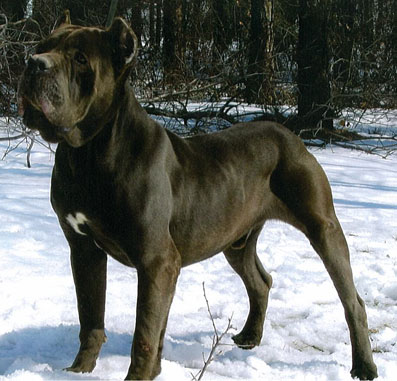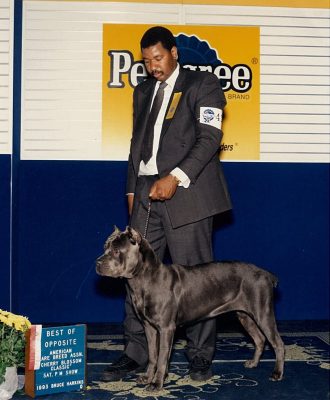|
History,
Description, and Temperament
| The Cane Corso is not the result of a recent
mixture of different dogs. On the other hand, he can boast of an
ancient history which dates back to over one thousand years. His
old ancestors, born in Tibet were named "Leontonix" by Aristotle,
meaning descendants of a lion. These mastino dogs, known to the
Italic peoples as "Canis Pugnax" (the old Roman Molossian), migrated
to Rome where they were noted as being lighter weight, less encumbered,
but just as powerful. They would often be seen fighting lion in
the Coliseums. These dogs that now earned their living in Rome,
were the Neapolitan Mastiff and the Cane Corso. The Cane Corso,
because of its athleticism was later put to greater use by Italian
farmers as they helped manage buffalo and sulky oxen to the slaughterhouses.
During wartime, he went ahead of the infantry. In addition, affluent
Italian families used the Cane Corso as a loyal guardian of their
small children at play. |

"Bodacious"
Pictured above is our Cielo's father. Bo was highly sought after because of his pure Italian import pedigree and his
awesome temperament .
|
|

"Cerberus’ Gr Ch. Prince"
|
Imported by DiGuardia Cane Corso upon the inception of the
Cane Corso in America. Prince is the sire of our cornerstone female, “Echo”. This makes Prince one of the Patriarchs of Cielo Blu. |
|
In the recent past, the Cane Corso has found an excellent preservation area in Southern Italy, especially in Puglia, Luciana, and Sannio. According to noted Italian Cane Corso enthusiast Stefano Gandolfi, his name derives from the Latin word "Cohors"
which means guardian or protector." |
| Thus, the Cane Corso's general appearance
is that of a mesomorphic animal whose body is longer than it is
tall. Probably the most athletic of the mastiff breeds, the Cane
Corso has the muscularity of a wrestler while maintaining the agility
and endurance of a marathon runner. A Cane Corso male should measure
a minimum of 24 inches at the withers and 100 pounds; females, 22
inches and 80 pounds. The ears may be cropped or uncropped, but
the tail is docked. The short, dense coat requires minimal weekly
grooming. Accepted colors include black, blue, fawn, chestnut, tawny,
and stag red, with or without brindle markings, as well as the less
desirable black-and-tan and blue-and-tan patterns. White may appear
on the chin, chest, and the front of the toes. |

"Corina",
Here again we have Quentin Bembry showing Corina, one of the matriarchs of Cielo Blu in 1993.
|
|
|
Today's Cane Corso is a stable,
protective dog that is highly territorial. While he may be aloof and
suspicious of strangers, he maintains loyalty and total submission
to his owner. Because the breed can be highly dominant toward people
and other dogs, plenty of socialization and obedience training should
be introduced to him at an early age. As stated previously, the Cane
Corso was used as a guardian of affluent families' children in Italy.
Because of this history, today's Cane Corso displays the ability to
discern a harmless, innocent child from a threatening individual who
means you harm. Thus, the Cane Corso craves regular affection, attention
and interaction with its family. This athletic breed thrives in a
house or apartment provided that its daily exercise needs are met.
|
|